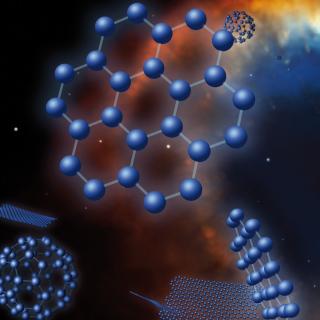Bibcode
Iglesias-Groth, S.; Manchado, A.; Rebolo, R.; González-Hernández, J. I.; García-Hernández, D. A.; Lambert, D. L.
Bibliographical reference
Monthly Notices of the Royal Astronomical Society, Volume 407, Issue 4, pp. 2157-2165.
Advertised on:
10
2010
Citations
52
Refereed citations
46
Description
We report the discovery of a new broad interstellar (or circumstellar)
band at 7088.8 +/- 2.0 Å coincident to within the measurement
uncertainties with the strongest band of the anthracene cation
(C14H10+) as measured in gas-phase
laboratory spectroscopy at low temperatures. The band is detected in the
line of sight of star Cernis 52, a likely member of the very young star
cluster IC 348, and is probably associated with cold absorbing material
in an intervening molecular cloud of the Perseus star-forming region
where various experiments have recently detected anomalous microwave
emission. From the measured intensity and available oscillator strength
we find a column density of implying that ~0.008 per cent of the carbon
in the cloud could be in the form of
C14H10+. A similar abundance has been
recently claimed for the naphthalene cation in this cloud. This is the
first location outside the Solar system where specific polycyclic
aromatic hydrocarbons (PAHs) are identified. We report observations of
interstellar lines of CH and CH+ that support a rather high
column density for these species and for molecular hydrogen. The
strength ratio of the two prominent diffuse interstellar bands at 5780
and 5797 Å suggests the presence of a `zeta'-type cloud in the
line of sight (consistent with steep far-ultraviolet extinction and high
molecular content). The presence of PAH cations and other related
hydrogenated carbon molecules which are likely to occur in this type of
clouds reinforces the suggestion that electric dipole radiation from
fast-spinning PAHs is responsible of the anomalous microwave emission
detected towards Perseus.
Related projects

Nucleosynthesis and molecular processes in the late stages of Stellar Evolution
Low- to intermediate-mass (M < 8 solar masses, Ms) stars represent the majority of stars in the Cosmos. They finish their lives on the Asymptotic Giant Branch (AGB) - just before they form planetary nebulae (PNe) - where they experience complex nucleosynthetic and molecular processes. AGB stars are important contributors to the enrichment of the
Domingo Aníbal
García Hernández